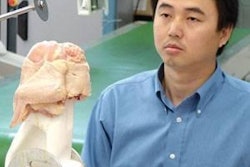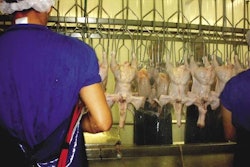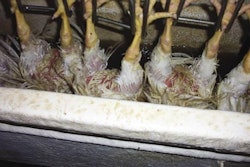.jpg?auto=format%2Ccompress&q=70&w=400)
With increased industrialisation and urbanisation, fast-food industries have picked up throughout the world, while there has been a reduction in home cooking. The processing and cooking of foods by restaurants and food manufacturers are different from domestic preparation: they tend to buy raw materials in bulk from a large poultry producer, who may use a number of chemicals, drugs, pesticides etc for optimum output. Moreover, machine washing and cleaning by fast-food industries may be less effective than hand washing at home, resulting in more residues. In order to gain market share, food manufacturers may add products to make foods tastier or more attractive, or to prolong shelf-life. Exceeding the permissible levels or the use of unauthorised products can be hazardous to human health. Proper checks using Hazard Analysis and Critical Control Points (HACCP) programmes are required at each stage of production.
Pesticide residues
Compared to greens, vegetables, seeds and fruits, residues of pesticides such as organochlorines, carbamates, fungicides and organophosphorus compounds in poultry products are negligible because animals are capable of eliminating these products, at least to some extent. There are no large risks for human health. Food and Agriculture Organization (FAO) and World Health Organization (WHO) recommend a maximum residual level of 0.01mg/kg for most pesticide residues in eggs and meat.
In a study on residues in eggs in northern India, 79% of samples had undetectable pesticide levels, and the rest had 0.026, 0.031, 0.014 and 0.013mcg/g egg of chlorpyrifos, endosulfan, deltamethrin and fenvalerate, respectively. In the poultrymeat samples, these values were 0.028, 0.022, 0.023 and 0.014mcg/g, respectively.
In poultrymeat and eggs, the tolerance levels were found to be 0.20, 0.05, 1.00, 0.10 and 0.20mg/kg of fat for aldrin, endrin, lindane, butylated hydroxy-compounds and heptachlor, respectively. In another study, about 10% of the 900 poultry liver samples were found to be positive for chlorpyrifos residues, ranging from 0.07 to 0.35mcg/g, with a mean of 0.085mcg/g.
Chlorinated hydrocarbons
A common type of chemical residue in poultrymeat is chlorinated hydrocarbons like chlorpyrifos and dichloro-diphenyl-trichloroethane (DDT), which will accumulate and are stored in body fat and act as a stimulant or depressant. The maximum residue level (MRL) for these compounds in eggs and meat are 0.1 and 0.2mg/kg, respectively.
Heavy metals
Tolerance levels of cadmium, lead, arsenic and mercury in eggs are 0.01, 0.10 and 0.03ppm, respectively. Entry of these heavy metals into the food chain is mainly due to environmental pollution. Fortunately, eggs are not a significant source of heavy metals because negligible amounts of these are able to penetrate the egg. Poultrymeat may be contaminated with toxic minerals like methyl mercury or lead as a result of coming into contact with the materials on the farm or factory or while moving through marketing channels. Arsenic accumulation might be due to excess use of arsanilic acid feed supplement or an inadequate withdrawal period. Selenium will accumulate in meat and eggs from birds fed grains grown in selenium-rich soils.
Drug residues
Chloramphenicol is by far the most studied antibiotic as a residue in eggs. It can persist in yolk for up to 66 days, depending on the dosage. Sulphadimidine and arsanilic acid have been found as residues in egg albumen.
Hormones are no longer used in poultry production.
Anticoccidials are widely used in poultry production and so there is some risk of residues in meat. Hence, withdrawal periods have been stipulated to each product. If followed meticulously, there should not be any danger of these chemicals to the consumers of poultry products. Since layers are mostly reared in cages and anticoccidials are rarely used in their feed, residues are uncommon in eggs.
US Food and Drug Administration (FDA) gives minimum withdrawal periods prior to slaughter: 5 days for many drugs, 3 days for tetracyclines and 10 days for sulfaquinoxaline. Recycling of some drugs through litter has posed additional problems, as this can result in low levels of these drugs in the meat. Vaccination is now gaining popularity for the control of coccidiosis, thus eliminating the risk of residue carry-over into poultry products.
Poultry products from extensive systems should be investigated for residues of anthelmintics, carbamates and pyrethroids, and these may require special controls.
Mycotoxin residues
Mycotoxins are generally consumed by poultry via the feed. Residues of mycotoxins or their metabolites in poultry at allowed levels and via natural exposure are generally very low. Some mycotoxins are carcinogenic, while others can be physiologically or pharmacologically active so adequate control measures are necessary to prevent problems by ensuring that the feed has no more mycotoxin than the maximum permissible level.
Microbial contamination
During poultry production and processing, bacteria such as salmonella, campylobacter and E. coli may enter the food chain through eggs and meat and cause food poisoning in humans. Unhygienic handling of raw and processed foods of animal origin poses a risk to human health although the birds may not be affected.
According to a survey conducted by Ontario Agricultural College, the chances of food poisoning due to egg consumption is only 1 in 1.6 million or 0.0000625% or once in 80 life-times, assuming an intake of 250 eggs per year for 80 years. The egg has a number of natural defence mechanisms, including the shell, lysozyme, macroglobulin, cuticle, ovo-inhibitors and immuno-globulins. Although food poisoning from eggs receives a great deal of media publicity, the risk of infection is, in fact, very low. No natural food can be guaranteed 100% safe and free from microbes and toxins.
Trans-fatty acids
Recently, trans-fatty acids have been identified as a major health hazard by WHO and American Dietetics Association. They occur mainly in further-processed, deep-fried products from fast-food outlets. Fatty acids in fats and oils are normally in the cis-form, which will be transformed to the less healthy trans-form during hydrogenation (shortening/vanaspathi) and over-heating during deep frying.
WHO has recognised that trans-fatty acids are more dangerous than any other fatty acids and can be compared to pesticide residues and mycotoxins in terms of the health risks they pose. Trans-fatty acids have been associated with atherosclerosis, other cardio-vascular diseases and oxidative degeneration. They are also carcinogenic and ulcerogenic. Trans-fatty acid content (see Table 1) is higher in foods that have been deep-fried in polyunsaturated fatty acid (PUFA)-rich oils from fish, sunflower, safflower or linseed than in those high in monounsaturated fatty acids (MUFA) and saturated fatty acids, like peanut, olive, palm or coconut.
Conclusions
Intensive poultry production methods and growth of the fast-food industry have tended to increase the risk of food contamination. However, food manufacturers are required to undergo HACCP training, be aware of food safety regulations and follow Good Manufacturing Practice (GMP). There must be rigorous quality control by strictly implementing the HACCP programme at each and every stage of food production and processing, and food technologists and microbiologists play an ever more important role in protecting consumers from the risks. A new programme Security Analysis and Risk Assessment Programme (SARAP) has been developed to meet these needs. SARAP will ensure the continued availability of the safe, readily available and economical food supply to consumers.

















